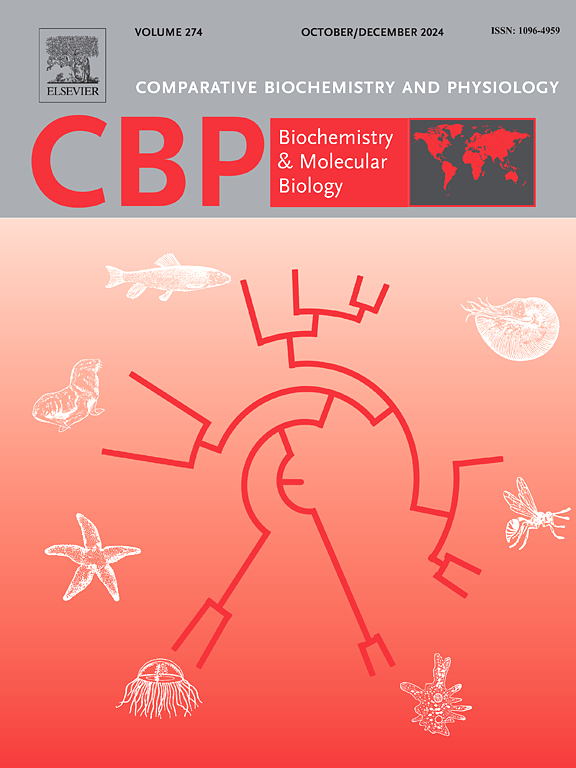The effect of agavin on the intestinal antioxidant response and its relationship to gut microbiota and plasma cortisol in Nile tilapia (Oreochromis niloticus) subjected to overcrowding stress
IF 1.8
3区 生物学
Q4 BIOCHEMISTRY & MOLECULAR BIOLOGY
Comparative Biochemistry and Physiology B-Biochemistry & Molecular Biology
Pub Date : 2025-08-09
DOI:10.1016/j.cbpb.2025.111144
引用次数: 0
Abstract
High-density aquaculture of Nile tilapia (Oreochromis niloticus) affects welfare by altering cortisol levels, antioxidant response (superoxide dismutase, catalase, and malondialdehyde), and gut microbiota. Agavin is a fructose- and glucose-based polysaccharide containing β-(2-1) and β-(2-6) linkages, known for its potential to mitigate the adverse effects of oxidative stress. This study evaluated the impact of agavin on the intestinal antioxidant response and investigated its correlation with gut microbiota composition and cortisol levels. Fish were fed a control diet (DC0, no agavin) or diets supplemented with 20 g kg−1 (D20) or 40 g kg−1 (D40) of agavin for 110 days. On day 90, all fish were subjected to high-density stress (63 kg m−3). Intestinal superoxide activity, catalase activity, and malondialdehyde concentrations were correlated with previously published plasma cortisol and microbiota data from the same study. Under high-density conditions, the D20 diet increased superoxide dismutase and catalase activity and reduced malondialdehyde concentration compared to the control. Plasma cortisol and malondialdehyde concentration showed a positive correlation (r = 0.67), but plasma cortisol was negatively correlated with superoxide dismutase activity (r = − 0.50). Sixty-nine and 81 operational taxonomic units (OTUs) were significantly correlated with catalase and superoxide dismutase activity, respectively, with families from the Order Cytophagales being strongly positively correlated. Cytophagales was also negatively correlated with plasma cortisol and malondialdehyde concentrations. These results suggest that, under stress conditions, agavin promotes the antioxidant response, modulating the intestinal microbiota and reducing cortisol release, which could indicate its utility as a prebiotic in aquaculture.

对过度拥挤应激下尼罗罗非鱼肠道抗氧化反应的影响及其与肠道微生物群和血浆皮质醇的关系
尼罗罗非鱼(Oreochromis niloticus)的高密度养殖通过改变皮质醇水平、抗氧化反应(超氧化物歧化酶、过氧化氢酶和丙二醛)和肠道微生物群来影响福利。Agavin是一种以果糖和葡萄糖为基础的多糖,含有β-(2-1)和β-(2-6)键,以其减轻氧化应激不良影响的潜力而闻名。本研究评估了agavin对肠道抗氧化反应的影响,并研究了其与肠道微生物群组成和皮质醇水平的相关性。饲喂对照饲料(DC0,不添加)或在饲料中添加20 g kg-1 (D20)或40 g kg-1 (D40) 110 d。在第90天,所有鱼都受到高密度应激(63 kg m-3)。肠道超氧化物活性、过氧化氢酶活性和丙二醛浓度与先前发表的血浆皮质醇和微生物群数据相关。在高密度条件下,与对照组相比,D20饲粮提高了超氧化物歧化酶和过氧化氢酶活性,降低了丙二醛浓度。血浆皮质醇与丙二醛浓度呈正相关(r = 0.67),与超氧化物歧化酶活性呈负相关(r = - 0.50)。69个操作分类单位(otu)和81个操作分类单位(otu)分别与过氧化氢酶和超氧化物歧化酶活性显著相关,与胞噬目家族呈显著正相关。细胞吞噬体也与血浆皮质醇和丙二醛浓度呈负相关。这些结果表明,在应激条件下,agavin促进抗氧化反应,调节肠道微生物群并减少皮质醇释放,这可能表明其作为水产养殖益生元的用途。
本文章由计算机程序翻译,如有差异,请以英文原文为准。
求助全文
约1分钟内获得全文
求助全文
来源期刊
CiteScore
4.60
自引率
4.50%
发文量
77
审稿时长
22 days
期刊介绍:
Comparative Biochemistry & Physiology (CBP) publishes papers in comparative, environmental and evolutionary physiology.
Part B: Biochemical and Molecular Biology (CBPB), focuses on biochemical physiology, primarily bioenergetics/energy metabolism, cell biology, cellular stress responses, enzymology, intermediary metabolism, macromolecular structure and function, gene regulation, evolutionary genetics. Most studies focus on biochemical or molecular analyses that have clear ramifications for physiological processes.

 求助内容:
求助内容: 应助结果提醒方式:
应助结果提醒方式:


